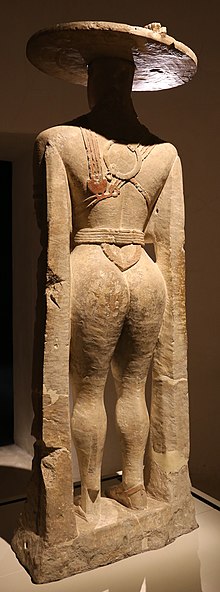Warriors of Capestrano
As a warrior of Capestrano , a statue is probably from the 6th century BC Chr. Made of limestone , which was discovered in 1934 near Capestrano in Abruzzo and which is in the Museo archeologico nazionale d'Abruzzo of Chieti .
The statue, which is probably used as a grave decoration, is 1.94 m high without plinth , 2.09 m high with plinth and depicts an armed Picener or Sabine who wears a broad-brimmed hat and an approximately circular cardiophylax , a chest protector for the area of the heart . He also carries a short sword, a dagger and an ax, and an apron-like miter covers his back. He is also equipped with a wide belt, a necklace, bracelets and two lances. Paint residues indicate reddish painting. In 2011, the statue was placed in a separate room in the Museo archeologico nazionale d'Abruzzo in the Villa Frigerj in Chieti.
A South Picenian inscription on a pillar or lance to the right of the warrior reads: makupri koram opsut ani <ni> s rakinelis pomp (une) i , analogously: "Aninis had this statue made extremely well for Rakinewis, the pomp [onier]", or also: "Annius Rakinelius made (this) statue for Pompo." However, the translation is only certain with regard to the core statement that an Annius made this statue. It is unclear whether pomp is a name or a designation of origin, ie rather "the pomponier" should be translated. The question of whether makupri means the adverb “good” is also open. The Roman archaeologist Adriano La Regina translated: "What a beautiful image Aninis made for King Nevio Pomuledio." It can no longer be clarified whether the statue represents the king or whether it was made for the king. Following the philologist Alberto Calderini (2007), so let Aninis make the statue, the sitter would accordingly the king. In the magazine National Geographic the question was raised whether the king is the mythical King Numa Pompilius of the early Roman period and whether he was not more of a Sabine . This question was also discussed in the general press, for example in the Corriere della Sera .
The statue was discovered by Michele Castagna in September 1934 in his vineyard. He informed the Soprintendenza alle Antichità in Rome , which had the work picked up from the house of Castagnas and brought to the Roman National Museum . Under the direction of Giuseppe Moretti , the site was then also examined archaeologically. He and his team discovered a necropolis from the 7th to 5th centuries BC. Not far from the ancient city of Aufinum , a female statue was also found, the Lady of Capestrano . At the beginning of the 21st century, further excavations followed, which unearthed around a hundred graves and 50 archaeological artifacts. Since in the early Etruscan period materials with a rather low durability were preferred, finds are extremely rare, especially those of this high quality and good preservation.
Stylistically, the statue is part of a series of comparable finds from Italy and Celtic art north of the Alps. For example, if the quality of the execution of statue B from the Etruscan necropolis of the Casa nocera in Casale Marittimo and the warrior from Hirschlanden differ in composition and style, they have similarities with the warrior from Capestrano. Ultimately, finds as far away as the Celtic prince from Glauberg are in this tradition and conception of art.
literature
- Adriano La Regina : Il guerriero di Capestrano e le iscrizioni paleosabelliche , in: Luisa Franchi dell'Orto (ed.): Pinna Vestinorum e il popolo dei Vestini , L'Erma di Bretschneider, Rome 2011, 230-273 ( online ).
- Alberto Calderini, Sergio Neri, Maria Ruggeri: Guerrieri e Re dell'Abruzzo antico , Carsa, Pescara 2007.
- Goffredo Palmerini: Il guerriero di Capestrano e la "Reggia" creata da Mimmo Paladino , in: italiani.ca. The Italian Canadian Web Magazine.
- Joe Basile: The Capestrano Warrior and Related Monuments of the Seventh to Fifth Centuries BC , in: Revue des archeologues et historiens d'art de Louvain 26 (1993) 9-31.
Web links
Remarks
- ^ Rex Wallace: The Sabellic Languages of Ancient Italy , Lincom Europa, 2007, p. 64.
- ^ Anna Marinetti: Le iscrizioni sudpicene , Olschki, Florenz 1985, p. 104.
- ^ "Me bella imagine fece Aninis per il re Nevio Pompuledio".
- ^ Carlo Maria d'Este: Il guerriero di Capestrano. Un'icona simbolo dell'Abruzzo e della sua identità , Sulmona 2015 ( online ( memento of the original from May 30, 2015 in the Internet Archive ) Info: The archive link has been inserted automatically and has not yet been checked. Please check the original and archive link according to the instructions and then remove this note. , PDF).
- ↑ Paolo Brogi: Si chiama Nevio Pompuledio ma è Numa Pompilio? In: Corriere della Sera , October 1, 2004.
- ^ Il Guerriero italico di Capestrano. Istituto poligrafico dello Stato, Rome 1936.


